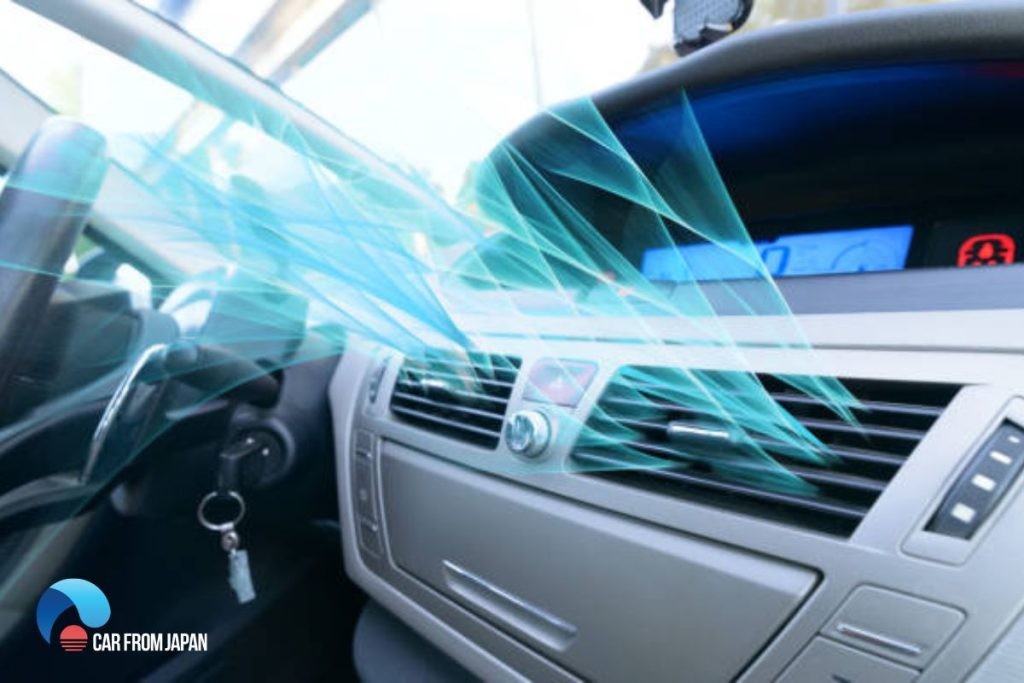Is your car’s air conditioning system failing to deliver that refreshing blast of cold air you crave? Before you resign yourself to sweaty drives, consider this: vacuuming your car’s AC system might be the solution. Learning How To Vacuum Ac System In Car isn’t just about routine maintenance; it’s a crucial step in ensuring your AC operates efficiently and effectively, keeping you cool and comfortable on the road.
This comprehensive guide will walk you through the DIY process of vacuuming your car’s AC system, saving you money and empowering you to maintain your vehicle’s climate control.
Step-by-Step Guide: How To Vacuum Car AC System
Neglecting to vacuum your car’s AC system can lead to a decline in performance due to dust, air, and moisture accumulation. Proactive maintenance, including periodic vacuuming, is key to preventing issues and ensuring your AC system continues to run smoothly. Let’s delve into the step-by-step process that allows you to perform this maintenance effectively at home.
1. Gather the Necessary Tools and Equipment
Before you begin, ensure you have all the right tools at hand. This will make the process smoother and safer. Here’s what you’ll need:
- AC Manifold Gauge Set: This is indispensable for measuring system pressure and connecting your vacuum pump to the AC system.
- Vacuum Pump: This powerful tool is designed to remove air and moisture efficiently from the AC system.
- Refrigerant Hoses: These color-coded hoses (typically red, blue, and yellow) connect the manifold gauge set and vacuum pump to your car’s AC service ports.
- AC Service Port Caps: These protective caps are vital for sealing the service ports when they are not in use, preventing contamination.
- Safety Glasses: Always prioritize safety. Protect your eyes from refrigerant and system pressure with safety glasses.
- Gloves: Wear gloves to protect your hands from potential contact with refrigerant and other automotive fluids.
2. Locate the AC Service Ports on Your Vehicle
To start the vacuuming process, you first need to identify the service ports on your car’s AC system.
Begin by parking your car on a level surface, ideally in a garage or shaded area. Ensure the engine and AC system are turned off and the vehicle is cool.
The AC system typically has two service ports: a high-pressure port and a low-pressure port. The high-pressure service port is usually larger in diameter than the low-pressure port. It is generally located between the condenser and the expansion valve or orifice tube.
To find the low-pressure service port, trace the AC compressor lines. It’s often positioned between the compressor and the evaporator. Look for a nozzle, which is usually capped, on the smaller diameter line.
Identifying these ports correctly is crucial before you proceed to the next step of connecting the manifold gauge.
3. Connect the Manifold Gauge Set
Connect the vacuum pump’s hose to the low-pressure port on the manifold gauge. (Photo: istockphoto)
Once you’ve located the service ports, you need to connect the manifold gauge set. This tool acts as an interface between your AC system and the vacuum pump, allowing you to monitor the pressure and facilitate the vacuuming process.
First, connect the yellow hose from your manifold gauge set to the vacuum pump. This connection is typically made to the central port on the manifold gauge, often situated between the high and low-pressure gauges.
Next, connect the red hose to the high-pressure service port of your car’s AC system and the blue hose to the low-pressure service port. Most manifold gauge sets and hoses are color-coded for easy identification.
Before making these connections to the car’s service ports, ensure that the valves on the manifold gauge (both high and low-pressure valves) are completely closed. This prevents any accidental release of refrigerant or air during the connection process.
4. Secure the Connections to the Service Ports
Now that you have the manifold gauge hoses connected, you need to properly attach them to the car’s AC service ports.
To connect a hose to a service port, lift the connector ring on the hose fitting upwards. While holding the ring up, push the fitting firmly onto the corresponding service port. Release the connector ring to lock the fitting in place. You should hear a click or feel the connector engage securely.
After connecting the hoses, you need to open the service valves within the ports. Typically, this is done by turning the valve knob on the hose fitting in a clockwise direction. This action depresses a small plunger inside the service port, opening the valve and allowing access to the AC system. Repeat this for both the high and low-pressure ports.
Ensuring all connections are tight and secure is paramount to achieve an effective vacuum and prevent leaks during the process.
5. Initiate the Vacuuming Process
Vacuum pressure should be monitored and reach approximately 27-29 inches of mercury (Hg). (Photo: istockphoto)
Before starting the vacuum pump, check that both gauges on the manifold gauge set read “zero” or atmospheric pressure. This confirms that the system is currently at ambient pressure before vacuuming begins.
Now, turn on the vacuum pump. You will likely hear the pump start running, and you should observe the gauges on the manifold gauge set starting to move. Specifically, the low-pressure gauge should begin to move into the vacuum range (negative pressure).
Monitor the low-pressure gauge as the vacuum pump operates. The goal is to pull a vacuum of around 27 to 29 inches of mercury (Hg). This level of vacuum is necessary to effectively remove air and moisture from the AC system.
Regarding how long to vacuum car AC system, the typical duration is between 30 to 45 minutes. This timeframe is generally sufficient to remove moisture and non-condensable gases from the system, ensuring optimal AC performance.
To begin the actual vacuuming, open both the high-pressure and low-pressure valves on the manifold gauge set. This allows the vacuum pump to pull a vacuum on the entire AC system.
Once the vacuuming process is complete (after approximately 30-45 minutes and reaching the target vacuum level), close both the high-pressure and low-pressure valves on the manifold gauge set. Then, you can switch off the vacuum pump.
Observe the low-pressure gauge. It should hold the vacuum reading you achieved (around 27-29 inches Hg). If the pressure reading starts to rise, it could indicate a vacuum leak in the system, which would need to be addressed before proceeding.
If the vacuum holds steady, you can then disconnect the vacuum pump hose (yellow hose) from the manifold gauge. At this stage, you can proceed to recharge the AC system with refrigerant if needed, or simply replace the service port caps to seal the system.
How Long To Vacuum Car AC System? Optimizing Vacuum Time
A common question is how long to vacuum AC system in car for optimal results. While the standard recommendation is 30-45 minutes, understanding the rationale behind this timeframe and potential time-saving techniques can be beneficial.
The primary reason for vacuuming for at least 30-45 minutes is to ensure the removal of moisture and non-condensable gases. Moisture, in particular, can be detrimental to AC system performance and longevity. A deep vacuum, reaching around 500 microns or 29.92 inches Hg gauge pressure, is necessary to boil off and remove any moisture that may have entered the system.
For systems that have been opened for component replacement, or if moisture contamination is suspected, a longer vacuum time might be necessary. Furthermore, replacing the AC receiver-drier or accumulator, which are designed to absorb moisture, in conjunction with vacuuming is a best practice for maintaining a dry system.
Leak Test for Efficient Vacuuming: To optimize your vacuuming time and avoid wasting time on a system with leaks, consider performing a vacuum leak test.
- Pull the system down to a vacuum (e.g., 28-29 inches Hg).
- Close the valves on the manifold gauge set.
- Turn off the vacuum pump.
- Monitor the low-pressure gauge for about 10 minutes.
If the vacuum reading remains stable (loses less than 1 inch of Hg in 10 minutes), the system is reasonably leak-free, and you can proceed with vacuuming for the recommended 20-30 minutes to remove moisture before recharging. If the vacuum drops significantly, it indicates a leak that needs to be identified and repaired before proceeding with system service. This leak test can save you time and refrigerant by preventing charging a system that will leak.
FAQs About Vacuuming Car AC Systems
What Happens If You Don’t Vacuum AC System?
Skipping the vacuuming step when servicing your car’s AC can lead to significant problems. Air and moisture are the enemies of an efficient AC system. If these contaminants are not removed by vacuuming, they can:
- Reduce Cooling Efficiency: Air and moisture displace refrigerant, reducing the system’s cooling capacity and leading to warmer air from your vents.
- Cause Component Damage: Moisture can react with refrigerant to form acids, which can corrode internal AC components, leading to premature wear and system failures.
- Increase System Pressure: Non-condensable gases like air increase system pressure, making the compressor work harder and potentially leading to compressor failure.
- Result in Costly Repairs: Neglecting vacuuming can lead to more serious and expensive repairs down the line, as components degrade and fail.
How Often Should I Vacuum My Car AC System?
It’s generally recommended to vacuum your AC system every time you open the system for service or recharge it with refrigerant. This ensures that any air or moisture introduced during the process is removed, maintaining system integrity. For systems that are functioning well and not opened, routine vacuuming is not typically necessary, but should be performed if performance declines or before any refrigerant work.
Can You Charge an AC System Without Vacuuming?
It is strongly discouraged and not recommended to charge an AC system without vacuuming it first. Charging without vacuuming introduces air and moisture into the system, leading to the problems outlined above (reduced cooling, damage, etc.). Vacuuming is an essential preparatory step for recharging, ensuring a clean and dry environment for the new refrigerant and maximizing cooling performance and system longevity. Think of vacuuming as preparing the system to receive the new refrigerant properly.
Do You Have to Vacuum Car AC Lines?
Yes, vacuuming the entire AC system, including the lines, is crucial. The lines, along with other components, can trap air and moisture. Vacuuming ensures that the entire closed system is free of contaminants, not just parts of it. This comprehensive approach is necessary for optimal refrigerant flow, cooling efficiency, and system reliability.
Wrapping Up: DIY Car AC Vacuuming
By following this step-by-step guide on how to vacuum AC system in car, you’re now equipped to perform this essential maintenance task yourself. Understanding the process and knowing how long to vacuum AC system empowers you to maintain your car’s AC effectively, potentially saving money on professional servicing and ensuring a comfortably cool driving experience. Remember to always prioritize safety, use the correct tools, and if you are ever unsure about any step, consult a qualified automotive technician.


